Why Use Oil Primer on Wood Cabinets?
If you are here I would guess you are either thinknign of painting yout kitchen cabinets, or having a apint contractor paint them for you. Painting your wood cabinets can be the most cost effective and imapctfull things you can do to your kitchen or bathroom. When done right, a fresh coat of paint can completely change the look and feel of your home without the hefty price tag and mess of a kitchen remodel. The key to a long-lasting, flawless finish often lies in using the right primer—and more often than not, that means an oil-based primer. So- Why Use Oil Primer on Wood Cabinets?
In this blog, we’ll dive deep into why using an oil primer on wood cabinets is so crucial, how to choose the right products, and some real-world considerations for homeowners in the western suburbs of the Fox Valley area.
Why Does Priming Wood Cabinets Matter So Much?
It doesnt matter where you live, The everyday wear and tear on kitchen cabinets—grease, cooking heat, spills—make a mess on wood cabients.
Getting rid of grease and oil is messy!!
Blocking grease and oil stains is a pain in the &(@^&!!!
When we look at wood cabients for painting, there are a few common issues we see with wood and painted cabinets:
- Chipping Paint: Paint can chip or peel—especially in moisture-heavy areas like kitchens and bathrooms. Primer helps mitigate- but the softest thing bends- the wood- leaving paint to chip.
- Stains and Bleed-Through: Wood tannins, knots, cooking products, cleaning products, oils from finger prints, food stains, as well as spices can bleed through paint if the surface isn’t sealed correctly, resulting in unsightly discoloration on your newly painted cabinets.
- Poor Adhesion: One of the most frequent complaints is that the paint doesn’t “stick” well to the wood surface, leading to a peelng, splotchy or uneven looking paint surfaces.
- Odor and Long Dry Times: Some primers can have strong odors or require extensive drying times, which can be inconvenient for busy households.
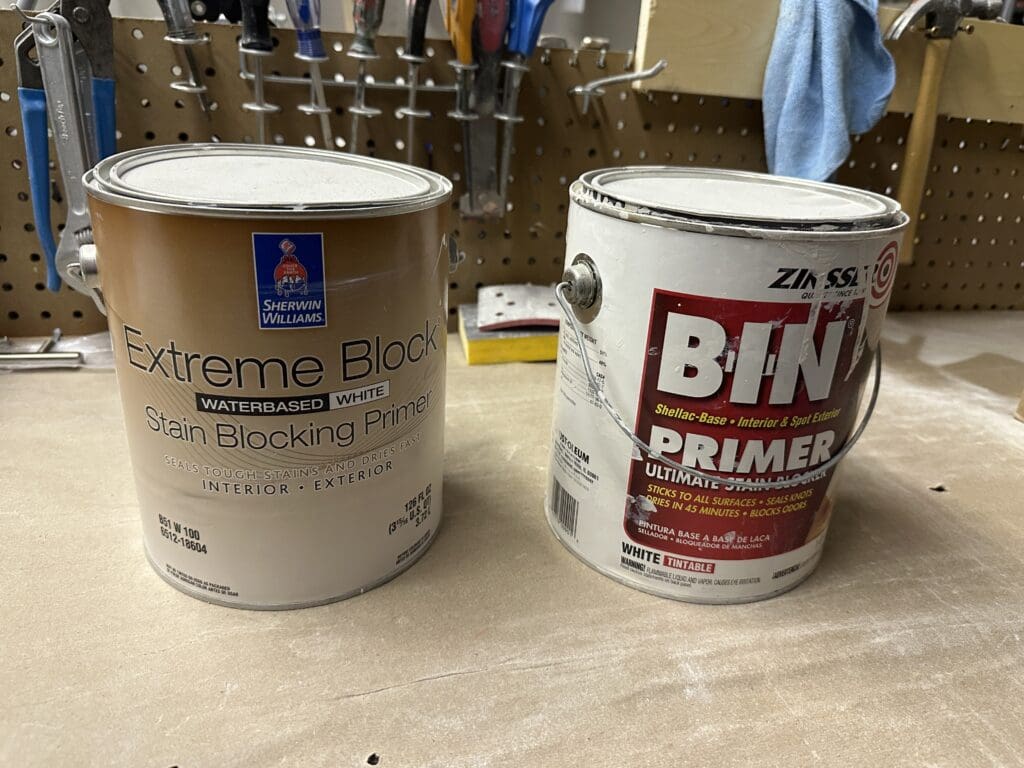
So how do you solve these problems? By selecting a primer that seals, adheres, and creates a solid foundation. That’s where oil and solvent based primers can help!
The Benefits of Using an Oil Primer for Wood Cabinets
Oil-based primers can be a real pain to use and they smell! There are some oil primers that have been a go to product for painters for decades, and for good reason.
- Superior Adhesion
Oil-based primers bond exceptionally well to wood. This strong adhesion means your paint job is less likely to peel or chip over time, which is especially important in high-traffic areas like kitchens. - Effective Stain Blocking
Wood cabinets often have tannins, knots, or other imperfections that can bleed through lighter paint colors. An oil primer effectively blocks these stains, ensuring a more uniform and clean finish. - Durability in Changing Climates
In places like Huntley, Crystal Lake, Algonquin, and the Fox Valley, we see rapid shifts in humidity and temperature. Oil primers provide a robust seal against moisture, helping your cabinet paint resist swelling and cracking. - Smooth Finish
Oil-based primers tend to level out nicely, creating a more uniform surface. This can be a huge benefit if you’re going for that smooth, professional-looking finish on your cabinets. - Longevity
Because oil-based primers offer better adhesion and stain blocking, your cabinet paint job is more likely to stand the test of time. That means fewer touch-ups and a kitchen or bathroom that looks gorgeous for years.
Top Oil Primer for Cabinet Painting
Let’s take a closer look at some of the leading oil-based primer options on the market. While you can find these at various paint stores, several are available locally in the Bartlett or Crystal Lake area, and many are well-known brands with good reputations.
- Sherwin Williams Pro Block
- Key Features: Known for strong adhesion and excellent stain-blocking capabilities. Pro Block helps prevent bleed-through from tannins or dark wood.
- Why It’s Great: This primer dries relatively quickly for an oil-based product. If you’re painting multiple cabinets, that quick turnaround can help keep your project moving smoothly.
- Zinsser Cover Stain
- Key Features: Cover Stain is a go-to for many pros because it’s versatile and effective on both interior and exterior surfaces.
- Why It’s Great: It blocks tough stains, including water stains, and can be top-coated with either oil or latex paint.
- Zinsser No Odor Oil Primer
- Key Features: Designed to address a major complaint: the strong smell associated with oil-based primers. It has minimal odor while still delivering top-notch stain-blocking.
- Why It’s Great: If you’re sensitive to fumes or don’t have much ventilation in your painting area, this product can be a lifesaver.
- BIN Shellac Primer
- Key Features: While technically a shellac-based primer, BIN is often grouped with oil primers because of its stain-sealing power. It’s ultra-fast drying and excellent for blocking stubborn odors (like cigarette smoke) as well as stains.
- Why It’s Great: The speed of drying can be a huge plus if you need to finish a project quickly. It’s also known for exceptional adhesion on tricky surfaces.
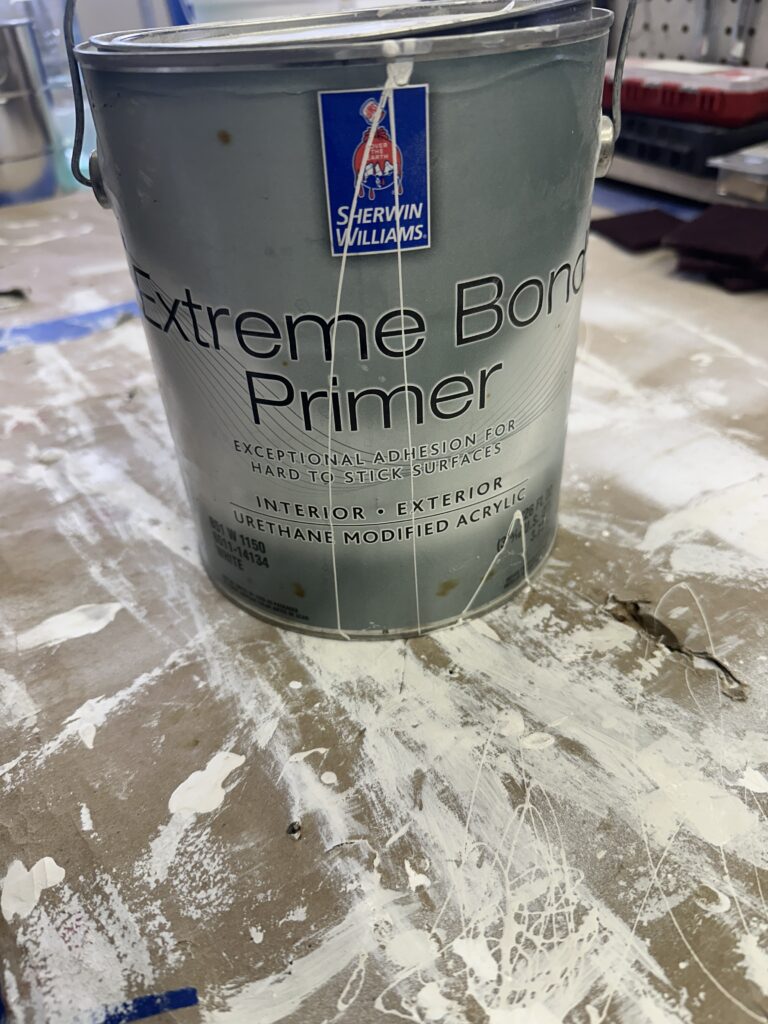

Step-by-Step Guide: How to Prime and Paint Your Wood Cabinets with Oil Primer
Note: Always follow the specific instructions on your primer’s label, as drying times and application methods can vary.
- Prep Your Space-Proper Preparation Prevents Poor Performance!
- Remove cabinet doors and hardware. Label everything so reassembly is a breeze.
- Cover countertops, floors, and appliances with drop cloths or plastic sheeting.
- Clean and Degrease– NASTY but Neccesary!
- Kitchens can accumulate grease film over time. Wipe down all surfaces with a degreaser or a mixture of warm water and TSP (trisodium phosphate).
- Rinse and let everything dry thoroughly.
- read more here...
- Sand the Surface– read more abot wet clean and snading here
- Lightly sand the cabinet surfaces to scuff the existing finish. Use a 220- or 320-grit sandpaper for this. This step helps the primer adhere better.
- Wipe away sanding dust with a tack cloth or vacuum.
- Apply the Oil Primer
- Stir the primer (don’t shake—this introduces bubbles).
- Use a high-quality brush and roller designed for oil-based paints to apply a thin, even coat of primer. (or spray)
- Allow the primer to dry fully (this can range from a few hours to overnight, depending on the product).
- Light Sanding Between Coats
- Lightly sand the primed surface again. This step ensures an ultra-smooth finish.
- Topcoat with Paint
- Once your oil primer has cured, you can topcoat with either an oil-based or a latex (water-based) paint. High-quality latex paints with enamel finishes are popular for cabinets.
- Apply at least two coats of your chosen paint, letting each coat dry per the instructions.
- read more about cabient paint here
- Reassemble
- Once everything is completely dry, reattach hardware and doors. Step back and admire your newly refreshed cabinets!
Real-World Example -Dfranco Painting Google review
From start to finish, it was a wonderful experience working with Dfranco on our kitchen cabinet project.They were reasonably priced, communicative, and professional. Anthony was our painter and he was very professional while he was in our home working.The cabinets turned out absolutely stunning and we couldn’t be happier with the finish. They are so smooth and the paint is gorgeous. Photos attached!
Highly recommend, we’ve already told all of our neighbors. We’re likely to schedule more painting jobs in the future when we need to paint the rest of the house!
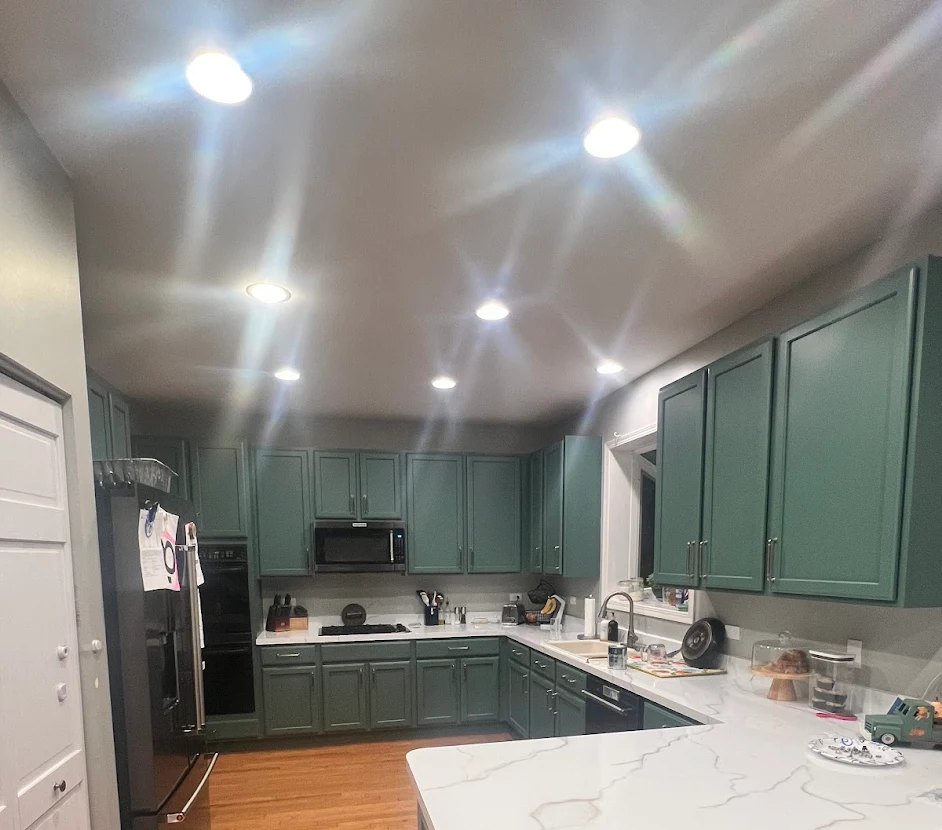
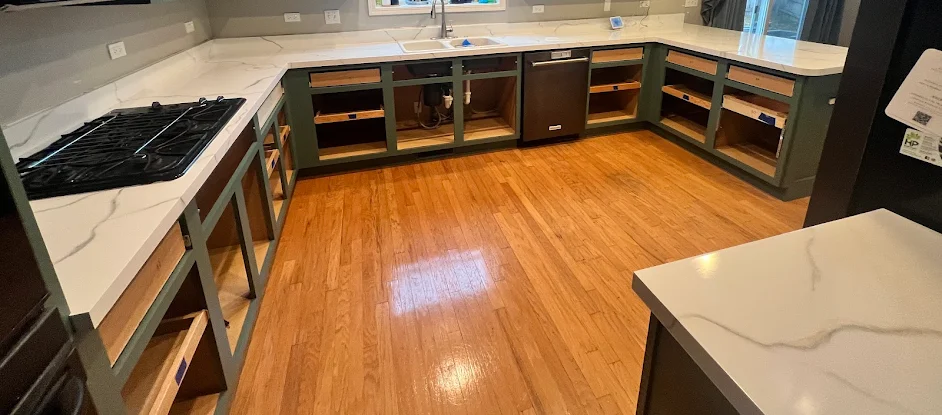
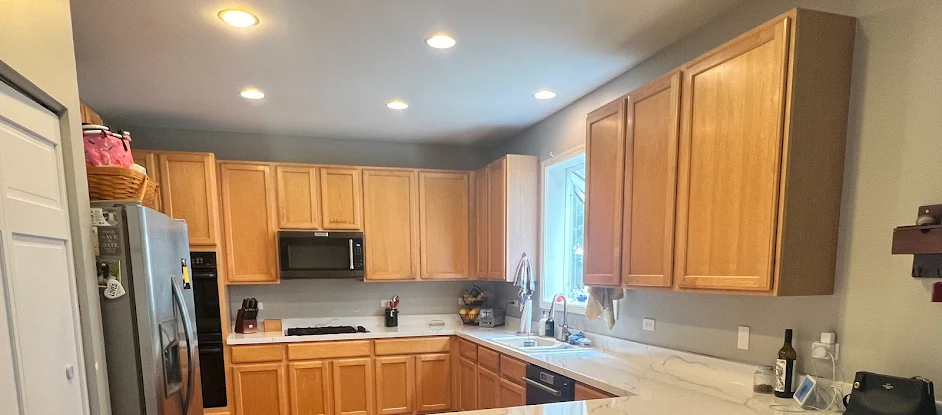
Frequently Asked Questions (FAQ)
Below are some of the top questions homeowners ask about using oil primer for wood cabinets. Addressing these concerns can help you decide whether it’s the right approach for your next cabinet painting project.
1. Is oil-based primer really necessary for wood cabinets?
Answer: While it’s not always “mandatory,” many painting professionals in Huntley, Bartlett, and the surrounding Fox Valley region swear by oil-based primers because of their superior adhesion and stain-blocking qualities. If you want a finish that stands up to humidity, cooking grease, and daily wear, oil primer is often your best bet.
2. Can I use a water-based primer instead?
Answer: Yes, you can—but you may not get the same level of adhesion or stain-blocking power as oil-based options. Water-based primers have improved greatly in recent years, but they can struggle with heavy tannins and persistent stains in certain types of wood. If you have oak or another wood prone to bleed-through, oil-based is usually more reliable.
3. What about the strong smell of oil-based primers?
Answer: Traditional oil primers do have a potent odor, which can linger. However, products like Zinsser No Odor Oil Primer are formulated specifically to address this problem. You’ll still want good ventilation—open windows, use fans—but the smell will be significantly less than older formulas.
4. How long does oil primer take to dry?
Answer: Drying times vary by product. Sherwin Williams Pro Block might be dry to the touch in a couple of hours, but you might need to wait 24 hours before applying another coat of primer or paint, especially in cooler or more humid conditions. Always check the manufacturer’s guidelines for the most accurate timelines.
5. Can I paint over oil primer with latex paint?
Answer: Absolutely! One of the best perks of oil primers is that they can be top-coated with either oil-based or latex paint. Many homeowners prefer a water-based (latex) paint for cabinets due to easier cleanup and lower odor.
6. Do I need to sand after applying the primer?
Answer: Light sanding between coats can help achieve a smoother, more professional-looking finish. This isn’t always required, but it’s often recommended if you notice any imperfections or if the primer’s instructions call for it.
Other Factors to Consider when painting cabinets
Living in the Western Suburbs of the Fox Valley—including Algonquin, Crystal Lake, and Bartlett—means dealing with temperature extremes. Winters can bring dry indoor heat, and summers can get quite humid. Oil primers are particularly well-suited for these conditions because they form a strong, flexible bond that resists moisture penetration. Whether you’re in a cozy older home in Algonquin or a newer construction in Crystal Lake, your wood cabinets are likely to expand and contract with the seasons. An oil primer’s durability helps maintain the integrity of your paint job year-round.
Additionally, if you have an older home in Bartlett or Huntley, you may be dealing with layers of old paint or varnish on your cabinets. Oil primers are adept at locking in those older layers and ensuring they don’t affect your new topcoat.
Practical Tips for a Smoother Project
- Ventilation: Even if you use a low-odor or no-odor formula, ensure good air circulation by opening windows or running fans.
- Quality Tools: Invest in high-quality brushes and rollers made for oil-based products. It makes a huge difference in the final outcome.
- Patience is Key: Proper drying times are crucial. If you rush between coats, you could compromise adhesion or end up with a tacky finish.
- Test a Small Area: If you’re unsure about color or finish, test a hidden corner of a cabinet before committing to the entire set.
When to Call a Professional
Painting wood cabinets can be a large undertaking—especially if you’re juggling work, family, and other responsibilities. If you’re concerned about the time commitment, or if you simply want that picture-perfect finish, hiring a professional is an excellent option. A local painting service familiar with the unique conditions of Huntley, Crystal Lake, Bartlett, and the Fox Valley suburbs will know exactly how to prep, prime, and paint your cabinets for maximum longevity.
Pros have the advantage of experience: they’ll know which primer best suits your specific type of wood, the existing finish, and your overall project goals. They’ll also have the proper tools and techniques to complete the job quickly and efficiently, minimizing the inconvenience to your daily life.
Conclusion: Oil Primer for a Cabinet Makeover That Lasts
If you’re aiming for a cabinet painting project that stands the test of time, oil primer for wood cabinets is a smart choice. With its superior adhesion, stain-blocking capabilities, and resilience in the face of Illinois’ climate extremes, oil-based primer remains a go-to for homeowners and pros alike. Products such as Sherwin Williams Pro Block, Zinsser Cover Stain, Zinsser No Odor Oil Primer, and BIN Shellac Primer each have their own unique benefits, but they all bring the reliability you need for a long-lasting finish.
Whether you choose to tackle the project on your own or call in a professional, remember that prep work—cleaning, sanding, and priming—is the foundation of a successful paint job. Once your cabinets are properly primed, you can select the topcoat paint that suits your style and enjoy a fresh new look that can revitalize your entire space.
Are you ready to transform your kitchen or bathroom cabinets? Proper priming is the key, and an oil-based primer might just be the secret ingredient you’ve been missing. If you have any lingering questions, feel free to reach out or consult a local painting pro who knows the unique demands of the western suburbs of the Fox Valley—and get ready to fall in love with your cabinetry all over again!
Looking to speak with someone who’s well-versed in cabinet painting and oil primers?
We’re here to help. Whether you’re in Huntley, Bartlett, Crystal Lake, or anywhere in the Fox Valley region, our team is ready to guide you through the process. Give us a call or shoot us an email, and let’s chat about how oil primer can elevate your wood cabinets to a whole new level of style and durability.


